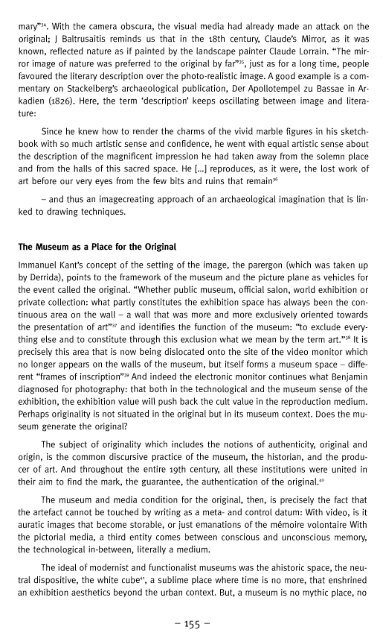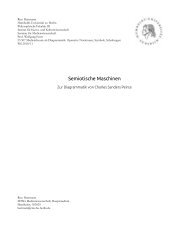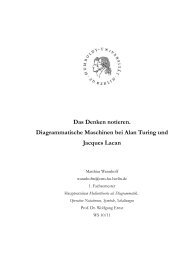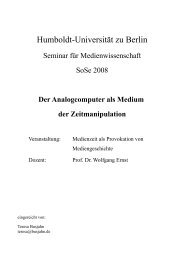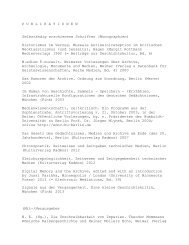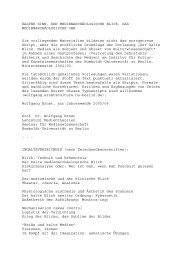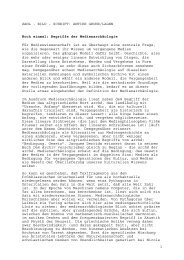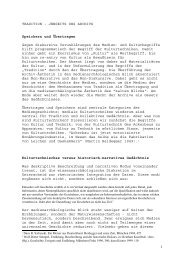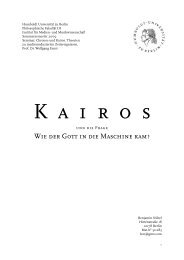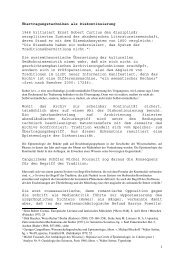Download - Medienwissenschaft
Download - Medienwissenschaft
Download - Medienwissenschaft
You also want an ePaper? Increase the reach of your titles
YUMPU automatically turns print PDFs into web optimized ePapers that Google loves.
mary" 34 . With the camera obscura, the visual media had already made an attack on the<br />
original; J Baltrusaitis reminds us that in the 18th century, Claude's Mirror, as it was<br />
known, reflected nature as if painted by the landscape painter Claude Lorrain. "The mirror<br />
image of nature was preferred to the original by far" 35 , just as for a long time, people<br />
favoured the literary description over the photo-realistic image. A good example is a commentary<br />
on Stackelberg's archaeological publication, Der Apollotempel zu Bassae in Arkadien<br />
(1826). Here, the term 'description' keeps oscillating between image and literature:<br />
Since he knew how to render the charms of the vivid marble figures in his sketchbook<br />
with so much artistic sense and confidence, he went with equal artistic sense about<br />
the description of the magnificent impression he had taken away from the solemn place<br />
and from the halls of this sacred space. He [...] reproduces, as it were, the lost work of<br />
art before our very eyes from the few bits and ruins that remain 36<br />
- and thus an imagecreating approach of an archaeological imagination that is linked<br />
to drawing techniques.<br />
The Museum as a Place for the Original<br />
Immanuel Kant's concept of the setting of the image, the parergon (which was taken up<br />
by Derrida), points to the framework of the museum and the picture plane as vehicles for<br />
the event called the original. "Whether public museum, official salon, world exhibition or<br />
private collection: what partly constitutes the exhibition space has always been the continuous<br />
area on the wall - a wall that was more and more exclusively oriented towards<br />
the presentation of art" 37 and identifies the function of the museum: "to exclude everything<br />
else and to constitute through this exclusion what we mean by the term art." 38 It is<br />
precisely this area that is now being dislocated onto the site of the video monitor which<br />
no longer appears on the walls of the museum, but itself forms a museum space - different<br />
"frames of inscription" 39 And indeed the electronic monitor continues what Benjamin<br />
diagnosed for photography: that both in the technological and the museum sense of the<br />
exhibition, the exhibition value will push back the cult value in the reproduction medium.<br />
Perhaps originality is not situated in the original but in its museum context. Does the museum<br />
generate the original?<br />
The subject of originality which includes the notions of authenticity, original and<br />
origin, is the common discursive practice of the museum, the historian, and the producer<br />
of art. And throughout the entire 19th century, all these institutions were united in<br />
their aim to find the mark, the guarantee, the authentication of the original. 40<br />
The museum and media condition for the original, then, is precisely the fact that<br />
the artefact cannot be touched by writing as a meta- and control datum: With video, is it<br />
auratic images that become storable, or just emanations of the memoire volontaire With<br />
the pictorial media, a third entity comes between conscious and unconscious memory,<br />
the technological in-between, literally a medium.<br />
The ideal of modernist and functionalist museums was the ahistoric space, the neutral<br />
dispositive, the white cube 41 , a sublime place where time is no more, that enshrined<br />
an exhibition aesthetics beyond the urban context. But, a museum is no mythic place, no<br />
-155 -


